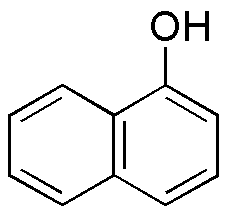a-Naphthol is widely utilized in research focused on
- Dyes and Pigments: It serves as a key intermediate in the production of various dyes, particularly in the textile industry, enhancing colorfastness and vibrancy.
- Pharmaceuticals: a-Naphthol is used in the synthesis of certain pharmaceuticals, providing essential properties for medicinal compounds, including analgesics and anti-inflammatory agents.
- Antioxidants: In the field of polymer chemistry, it acts as an antioxidant, helping to improve the stability and longevity of plastics and rubber products.
- Analytical Chemistry: It is employed in various analytical methods, such as spectrophotometry, to detect and quantify specific substances, making it valuable in quality control processes.
- Biological Research: a-Naphthol is used in biochemical assays to study enzyme activities and metabolic pathways, aiding researchers in understanding cellular processes.
General Information
Properties
Safety and Regulations
Applications
a-Naphthol is widely utilized in research focused on
- Dyes and Pigments: It serves as a key intermediate in the production of various dyes, particularly in the textile industry, enhancing colorfastness and vibrancy.
- Pharmaceuticals: a-Naphthol is used in the synthesis of certain pharmaceuticals, providing essential properties for medicinal compounds, including analgesics and anti-inflammatory agents.
- Antioxidants: In the field of polymer chemistry, it acts as an antioxidant, helping to improve the stability and longevity of plastics and rubber products.
- Analytical Chemistry: It is employed in various analytical methods, such as spectrophotometry, to detect and quantify specific substances, making it valuable in quality control processes.
- Biological Research: a-Naphthol is used in biochemical assays to study enzyme activities and metabolic pathways, aiding researchers in understanding cellular processes.
Documents
Safety Data Sheets (SDS)
The SDS provides comprehensive safety information on handling, storage, and disposal of the product.
Product Specification (PS)
The PS provides a comprehensive breakdown of the product’s properties, including chemical composition, physical state, purity, and storage requirements. It also details acceptable quality ranges and the product's intended applications.
Certificates of Analysis (COA)
Search for Certificates of Analysis (COA) by entering the products Lot Number. Lot and Batch Numbers can be found on a product’s label following the words ‘Lot’ or ‘Batch’.
*Catalog Number
*Lot Number
Certificates Of Origin (COO)
This COO confirms the country where the product was manufactured, and also details the materials and components used in it and whether it is derived from natural, synthetic, or other specific sources. This certificate may be required for customs, trade, and regulatory compliance.
*Catalog Number
*Lot Number
Safety Data Sheets (SDS)
The SDS provides comprehensive safety information on handling, storage, and disposal of the product.
DownloadProduct Specification (PS)
The PS provides a comprehensive breakdown of the product’s properties, including chemical composition, physical state, purity, and storage requirements. It also details acceptable quality ranges and the product's intended applications.
DownloadCertificates of Analysis (COA)
Search for Certificates of Analysis (COA) by entering the products Lot Number. Lot and Batch Numbers can be found on a product’s label following the words ‘Lot’ or ‘Batch’.
*Catalog Number
*Lot Number
Certificates Of Origin (COO)
This COO confirms the country where the product was manufactured, and also details the materials and components used in it and whether it is derived from natural, synthetic, or other specific sources. This certificate may be required for customs, trade, and regulatory compliance.


